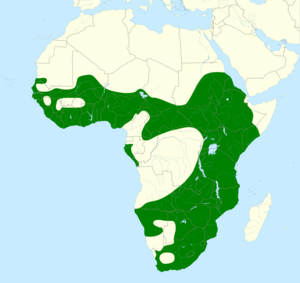Yellow-billed egret facts for kids
Quick facts for kids Yellow-billed egret |
|
|---|---|
 |
|
| Conservation status | |
| Scientific classification | |
| Genus: |
Ardea
|
| Species: |
brachyrhyncha
|
 |
|
| Range of the yellow-billed egret (Ardea brachyrhyncha) | |
| Synonyms | |
|
|
The yellow-billed egret (scientific name: Ardea brachyrhyncha) is a type of heron. It's a medium-sized bird found in Sub-Saharan Africa. Until recently, it was thought to be a subspecies of the intermediate egret. But now, scientists consider it its own unique species.
Contents
Yellow-billed Egret: Its Scientific Name
How Scientists Name Animals
Scientists give every animal a special name. This helps everyone know exactly which animal they are talking about. The yellow-billed egret was first named Herodias brachyrynchus. This was done by a German scientist named Alfred Brehm in 1854. He found it near the Blue Nile river.
A New Species
For a long time, the yellow-billed egret was seen as a part of the intermediate egret. The intermediate egret lives in Asia. However, on September 26, 2023, a group of bird experts decided something new. The International Ornithological Congress said that the yellow-billed egret is its own species. This means it is now officially different from the intermediate egret.
What Does the Yellow-billed Egret Look Like?
Size and Color
The yellow-billed egret is about 61 to 69 centimeters long. That's like two rulers put together! It has white feathers all over its body. It looks a bit like the great egret, which is another type of heron.
Special Features
The yellow-billed egret has a smaller beak than the great egret. Its mouth opening does not go past its eye. When it's time to breed, the egret grows long, fancy feathers. These plumes appear on its back and chest.
Changing Colors
The egret's beak is usually yellow. But during breeding season, it turns orange-red. Sometimes, the beak has a black tip when it's not breeding season. Its lower legs and toes are dark. The upper part of its legs (tibia) is lighter. It turns pinkish-red for a short time when the birds are looking for a mate. Then it changes to yellow for the rest of the breeding season.
The skin around its eyes (lores) is yellow. This skin also changes color during breeding. It becomes green, and the egret's eyes turn bright red. After the eggs are laid, these special breeding colors fade away.
Where Does the Yellow-billed Egret Live?
The yellow-billed egret lives in Africa. You can find it south of the Sahara Desert. It lives from southern Mauretania and Sudan all the way down to South Africa. It avoids very dry deserts and thick tropical forests. Sometimes, it has been seen in places like the Seychelles and the Cape Verde Islands. These are rare visits.
Where Does the Yellow-billed Egret Like to Live?
This egret prefers wet places. You can often see it in wetlands that flood during certain seasons. It also likes grassy areas that get wet. It lives on the shallow edges of lakes and rivers. You might find it near salty areas called salt pans or in estuaries, where rivers meet the sea.
Yellow-billed Egret: Life and Habits
Movement and Social Life
Yellow-billed egrets usually stay in one area. But they do move around locally. They travel to find better places when water levels change. They often hang out in loose groups of 15 to 20 birds. However, you can also see them by themselves. They often share their living spaces with other types of egrets. At night, they sleep in trees, including mangrove trees.
What Do They Eat?
This egret mainly eats fish and frogs. It also eats smaller amounts of insects and other tiny creatures. These can be found in water or on land.
Reproduction and Life Cycle
Yellow-billed egrets breed in large groups. These groups are often mixed with other bird species. They build their nests in trees that are over water or in swamps. The nest is made of sticks, rushes, and reeds. It is lined with grass. They build these nests in trees, bushes, or thick reedbeds. Each pair defends a small area around their nest from other egrets.
The breeding season happens during or right after the rainy season. Both parent birds take turns sitting on the eggs to keep them warm.


